By Rich Heidorn Jr.
PJM said Monday that its generation fleet performed much better in this New Year’s cold snap than during the 2014 polar vortex, but that high uplift costs during the event signal the need for its proposed pricing rule changes.
The RTO’s report on the Dec. 28, 2017, to Jan. 7, 2018, cold snap noted that temperatures were higher and customer demand lower than in 2014, although it did record its sixth highest winter peak on Jan. 5, when demand hit 137,522 MW in the 6-7 p.m. hour.
It reported a maximum of only 23,751 MW of forced outages (12.1% of total capacity) on Jan. 5, a little more than half the 40,200 MW lost on Jan. 7, 2014 (22% of capacity). The report echoed the message CEO Andy Ott delivered to a Congressional hearing in January. (See FERC, RTOs: Grid Performed Better in Jan. Cold Snap vs. 2014.)
“PJM did not call a performance assessment interval, a 72-hour maintenance recall or any transient shortage intervals. … Even during peak demand, PJM had excess reserves and capacity,” the report said. “Many factors drove this improved performance. In addition to the milder weather, these include enhancements PJM and its member companies have put in place in the years since the polar vortex, such as increased investment in existing resources, improved performance incentives, enhanced winterization measures and increased gas-electric coordination.”
However, PJM’s operators dispatched many generators that did not set LMPs, resulting in average uplift charges of $4.3 million per day during the peak of the recent cold, 11 times the normal average of $389,000 per day.
“On these days when the system is under additional stress, the actions the operators take to ensure that reliability is maintained are often not reflected in the transparent clearing prices. This problem, clearly evidenced by the cold weather experience, highlights the need for PJM and its stakeholders to evaluate reforms to address this issue in a timely manner,” PJM said. “These reforms include enhancing the manner in which reserves are procured and priced so that all operator actions are included in price signals and enhancements to the calculation of locational marginal pricing.”
PJM said it received cost-based energy offers exceeding $1,000/MWh between Jan. 3 and Jan. 7, but that “due to system conditions,” the resources did not receive day-ahead awards or run times during each of the operating days.
In December, PJM won stakeholder endorsement for creation of the Energy Price Formation Senior Task Force, which is considering rule changes to ensure prices accurately reflect the cost of serving load and minimize the need for uplift. The task force is scheduled to hold its fourth meeting March 5.
The report said PJM needs to continue improving its gas-electric coordination “to include improved contingency modeling and improved information sharing with local distribution companies.”
“Another area of fuel security that needs additional analysis, and potentially additional tools for operators and owners, is tracking and transportation of fuel oil supplies. While oil is typically a backup resource, PJM resources used more oil during the cold snap, which stressed some resources and supplies,” the RTO said.





